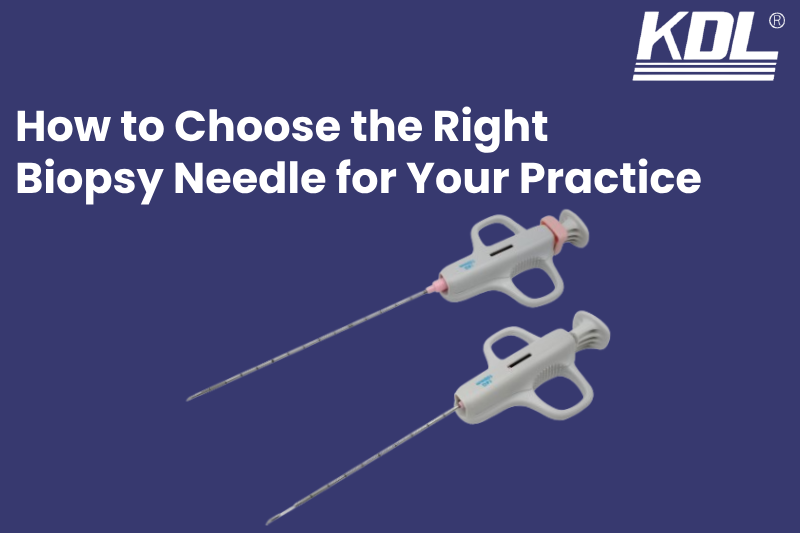
In the ever-evolving landscape of medical diagnostics, biopsy needles play a pivotal role in acquiring tissue samples for accurate pathological examination. This article explores the crucial aspects of selecting the right biopsy needle for your practice.
Biopsy needles serve as indispensable tools in medical practices, facilitating the extraction of tissue samples for diagnostic purposes. The choice of the right biopsy needle is a decision that significantly influences diagnostic accuracy and patient outcomes.
What is Biopsy needle
A biopsy needle is a medical instrument use to obtain a small sample of tissue from a living organism for diagnostic purposes. Biopsies are commonly performed to investigate and diagnose various medical conditions, including cancer, infections, inflammatory disorders, and other abnormalities. The collected tissue sample is then examined under a microscope by a pathologist to determine the nature of the cells and the presence of any abnormalities.
Understanding Biopsy Needle Types
1.Core Biopsy Needles
Core biopsy needles operate on the principle of extracting a cylindrical sample of tissue, allowing for a comprehensive analysis. The advantages lie in obtaining intact tissue architecture, aiding precise diagnosis. However, practitioners must be mindful of the limitations, such as potential tissue fragmentation during extraction.
2.Fine Needle Aspiration (FNA) Needles
FNA needles, on the other hand, involve the aspiration of cellular material for analysis. This technique is particularly suitable for soft tissues and organs. Understanding the nuances of FNA procedures and its adaptability to different tissue types is crucial for practitioners seeking optimal diagnostic results.
3.Vacuum-Assisted Biopsy Needles
Integrating vacuum technology into biopsy needles enhances the efficiency of tissue collection. This method proves beneficial in obtaining larger tissue samples with minimal passes, reducing patient discomfort. Knowing the indications for using vacuum-assisted biopsy needles ensures their appropriate deployment in specific cases.
Understanding the Importance of Choosing the Right Biopsy Needles
When it comes to performing biopsies, choosing the right biopsy needle is paramount for ensuring accurate and successful procedures. The biopsy needle you select can significantly impact the quality of the tissue sample obtained, the patient’s comfort during the procedure, and the overall efficiency of the biopsy process.
Factors to Consider When Selecting a Biopsy Needles
1.Needle Gauge and Length
The gauge and length of the biopsy needles play a crucial role in determining its suitability for different types of tissue samples and procedural requirements. Smaller gauge needles are ideal for soft tissues, while larger gauge needles are better suite for tougher or denser tissues. Similarly, the length of the needle should be choose base on the depth of the tissue to be sampled.
2.Needle Tip Design
The tip of the biopsy needles can come in various designs, including beveled, trocar, and side-cutting tips. Each tip design serves a specific purpose and is suite for different biopsy techniques and tissue characteristics. Understanding the advantages and limitations of each tip design is essential for making an informed decision.
3.Procedure Requirements
Different biopsy procedures may necessitate specific needle characteristics such as size, gauge, and penetration depth. Understanding the unique requirements of each procedure is essential for selecting the most appropriate biopsy needle.
4.Compatibility with Imaging Modalities
For guide biopsy procedures, such as ultrasound or CT-guide biopsies, it is crucial to ensure that the biopsy needles are compatible with the imaging modality being used. This compatibility ensures accurate placement of the needle and precise targeting of the tissue to be sampled.
5.Sample Retrieval Mechanism
Biopsy needles may feature different sample retrieval mechanisms, such as manual or automatic devices for retaining the tissue sample. The choice of sample retrieval mechanism should align with the specific procedural requirements and the desired sample size and quality.
6.Patient Comfort and Safety
Considering the patient’s comfort and safety during the biopsy procedure is essential. Choosing a biopsy needle with features that minimize trauma, reduce pain, and ensure precise targeting can significantly improve the overall patient experience.
7.Cost and Accessibility
Balancing the cost of biopsy needles with their quality and accessibility is essential for optimizing resources within a healthcare practice. Evaluate the long-term benefits of investing in high-quality biopsy needles that align with your practice’s budget and operational needs.
The Importance of Consulting with Peers and Experts
Given the multitude of factors to consider when selecting a biopsy needle, consulting with peers, experienced colleagues, and product experts can provide valuable insights and recommendations. Sharing knowledge and experiences within the medical community can help in making informed choices and staying updated on the latest advancements in biopsy needles technology.
Conclusion
Choosing the right biopsy needle for your practice requires careful consideration of various factors, including needle gauge and length, tip design, compatibility with imaging modalities, sample retrieval mechanism, and patient comfort and safety. By staying informed about the available options and seeking guidance from peers and experts, healthcare professionals can ensure that their biopsy procedures are conducted with precision, efficiency, and patient-centric care.
 +86-791-8686-1216
+86-791-8686-1216 

